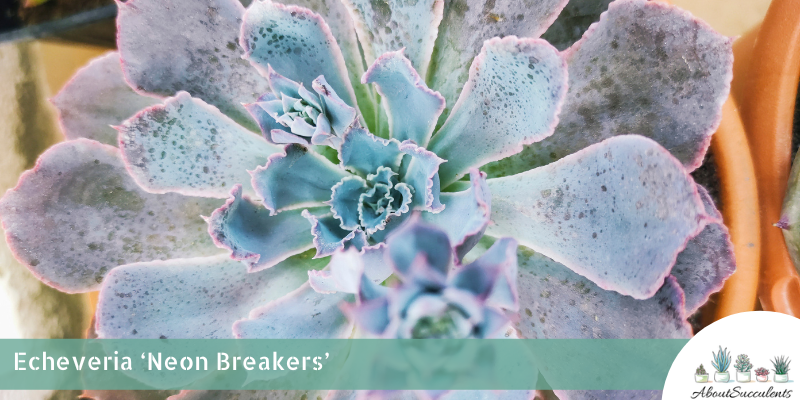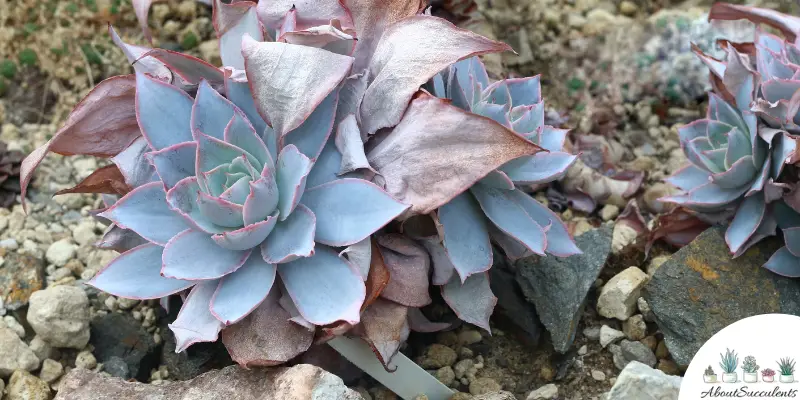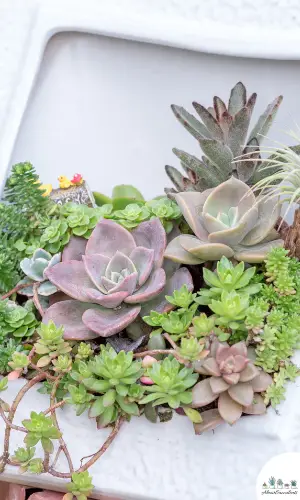
Echeveria “Neon Breakers” is an evergreen succulent that impresses horticulturists and their guests alike with its frilly leaves that start out with a blue-green color and a hint of fair pink hue at the edges.
However, when Echeveria is given consistent exposure to direct sunlight, the leaves transform into a majestic purple color with captivating, bright reddish-pink colors on its tips.
The leaves form into a beautiful and charming royal purple rosette that can reach a diameter of 8-inches (20cm). Neon Breakers can grow to a maximum height of 3-inches (7.6cm).
Echeveria Neon Breakers will produce flowers from the late summer to early spring. The flowers start out with a faint pink color that intensifies in hue over time.
Another common name associated with Neon Breakers is “Hens and Chicks” because it produces small offsets or pups near its base. These offsets can be pulled out and used for propagation.
Echeveria Neon Breakers is native to Central America, particularly Mexico. It belongs to the popular genus Echeveria and is a member of the Crassulaceae family.
Hens and Chickens is a hybrid created by Renee O’Donnell who combined Echeveria Pink Frills Shaviana with another unidentified Echeveria.
General Information
Also known as: Neon Breakers and Hens and Chicks
Plant Family: Crassulaceae
Origin: Central America and Mexico
Height: 3-inches (7.6cm)
Exposure: Partial or full sun for up to 6 hours per day but for the plant to achieve its full colors, exposure to direct bright sunlight is recommended
Water Needs: Drought-tolerant; follow the “Soak and Dry” method
Soil Type: Succulent soil mix with added gritty materials like coarse sand, pumice, and perlite for better drainage
Soil pH: 6.0
How to Grow and Care for Echeveria “Neon Breakers”

Echeveria Neon Breakers is a popular choice for experienced and first-time succulent hobbyists for 3 reasons.
First, Hens and Chicks is a variety of succulents that is highly tolerant to drought conditions and comparatively pest-resistant. Second, this type of Echeveria is a prolific grower especially when grown outdoors. Lastly, Neon Breakers is easy to grow and care for.
Because of its lively and exuberant colors, Echeveria Neon Breakers is commonly displayed as a decorative plant in succulent, dish, and rock gardens. Its attention-getting rosettes make Hens and Chicks an ideal centerpiece on your patio.
One thing you need to keep in mind when growing and caring for Echeveria Neon Breakers is that it’s not cold-hardy.
If you live in an area where you have days where the temperature drops below 30° F (-1.1° C), it would be best to plant the succulent in a pot you can move indoors.
Sunlight
Echeveria Neon Breaker won’t mind getting exposed to partial or full sun. However, to bring out the full spectrum of colors at their most intense and vivid hues, it would be best to give Neon Breaker full sun exposure.
As an outdoor succulent, plant Hens and Chicks in a location that gets partial to full sun for up to 6 hours every day. Don’t expose Echeveria to the heat of the afternoon sun.
Neon Breaker might be tolerant to drought but its leaves can burn under the harsh heat of the afternoon sun.
As an indoor plant, position the pot near a window that gets 4 to 6 hours of partial sun per day. An east or west-facing window would be the ideal location for Neon Breakers.
Don’t neglect Echeveria Neon Breakers when it comes to sunlight. If the succulent doesn’t get enough of the sun’s rays, etiolation can take place.
Etiolation is a condition where the leaves stretch out as if looking for the sun. The leaves will eventually wither and die.
Watering

Similar to other succulent plants, Echeveria Neon Breakers stores water in its leaves and stems. The ability to store water allows Echeveria to survive long, dry periods.
Watering the soil while it still contains moisture will create an environment that’s conducive to the growth of fungi. Likewise, the roots of Hens and Chicks can rupture, rot, and give the fungi an opening to infect the entire plant.
To know when it’s the right time to water the soil, follow the ”Soak and Dry” method.
Give the soil a good drenching only when you’ve confirmed that it’s 100% dry. You can easily do this by inserting your finger or a stick, an inch deep into the soil. If it feels dry to the touch, then you can prepare the soil for watering.
In the summer and spring months, you might find yourself watering the soil every seven to 10 days. In contrast, moisture stays longer during the winter months. You might water the soil only once a month.
Pot and Soil
If the Echeveria Neon Breakers succulent you bought was housed in a plastic container, replace it right away with one that’s made of either unglazed ceramic or terracotta.
Unglazed ceramic and terracotta have been proven to be the best materials to grow succulent plants in because the materials allow moisture to escape from the soil. Look for pots that have drain holes at the bottom large enough to filter out excess water.
Echeverias thrive in the driest regions of Mexico. These plants are used to grow in poor soil conditions. It’s important to plant Hens and Chicks in well-draining soil such as a commercial succulent mix.
It would be a good idea to add 50% more gritty materials such as coarse sand, pumice, and perlite to speed up soil drainage.
Fertilizer is not necessary but feeding the soil once a month during the growing season will give your plant more nutrition. Choose a fertilizer brand that offers a 20/20/20 mix and dilute the formula down to ¼ its original strength.
How to Propagate Echeveria “Neon Breakers”
We mentioned earlier that Echeveria Neon Breakers produces offsets you can use to propagate the species and add to your collection.
There are 2 other ways you can consider propagating Hens and Chicks: Leaves and Stem Cuttings.
Let’s start with offsets.
Offsets Method
Step 1: Use a sterilized and sharpened knife to free up the offsets then gently pull them out of the soil.
Step 2: Give the offsets 2 to 4 days to dry out and develop hard calluses.
Step 3: Plant the callused offsets in well-draining soil.
Step 4: Lightly moisten the soil with water and place the pot near a window that gets 4 to 6 hours of partial sunlight per day.
Step 5: If the roots have formed, water the soil only when it has gone dry.
Leaves Method
Step 1: Choose a healthy leaf and perform a smooth twist and pull. If a part of the leaf remains on the stem, repeat the process to ensure successful propagation.
Step 2: Allow the leaves to dry out and callus over. This step will take around 2 to 4 days.
Step 3: Place the calluses leaves on a well-draining succulent soil mix.
Step 4: Spray the soil with water and move the pot near a window that brings in 4 to 6 hours of partial sunlight every day.
Step 5: If the roots have taken hold, follow the “Soak and Dry” method when watering the soil.
Cuttings Method
Step 1: Choose a healthy stem and cut off a small section using a sterilized knife or garden shears.
Step 2: Let the stem cuttings dry out for 2 to 4 days or until they’ve grown calluses.
Step 3: Place the stem cuttings on a pot filled with well-draining soil.
Step 4: Water the soil lightly and place the pot near a window that gets 4 to 6 hours of sunlight on a daily basis.
Step 5: Examine the roots. If the presence of roots is evident, only water the soil when it has completely dried out.
Frequently Asked Questions
Is Echeveria “Neon Breakers” Toxic To Cats and Dogs?
Echeveria Neon Breakers doesn’t appear in the list of plants that are toxic to cats and dogs found on the website of the American Society for the Prevention of Cruelty to Animals (ASPCA).
Why Is My Echeveria “Neon Breakers” Dying?
Echeveria Neon Breakers remains a durable succulent but it’s susceptible to root rot from overwatering and fungal infection due to pest infestation. If these conditions aren’t treated right away, Hens and Chickens can die.
Overwatering
If you notice discoloration on its magnificent leaves or if they feel mushy, act right away and cut off these sections because they could be infected by fungi.
Use a sharp but sterilized knife to remove all of the infected sections. Once these sections are removed, uproot the plant and do the same to the roots that have rotted away.
Let the succulent dry out for 1-2 days before repotting. Use a new pot for Neon Breakers’ home and fill it up with fresh well-draining soil.
After repotting Echeveria, give it 2-3 days to get used to the new environment before watering the soil.
Pest Infestation
Mealybugs are the worst offenders because these pests want to drain the succulent of precious sap. They also leave substances that can infect your succulents.
Remove the white, cotton-like substances with a cotton ball dipped in 70% isopropyl alcohol. Spray the plant with diluted neem soil to get rid of pests.
Yes, Echeveria Neon Breakers produce pinkish flowers from late summer to early spring.
Last Updated on June 9, 2022 by Sofia Lara